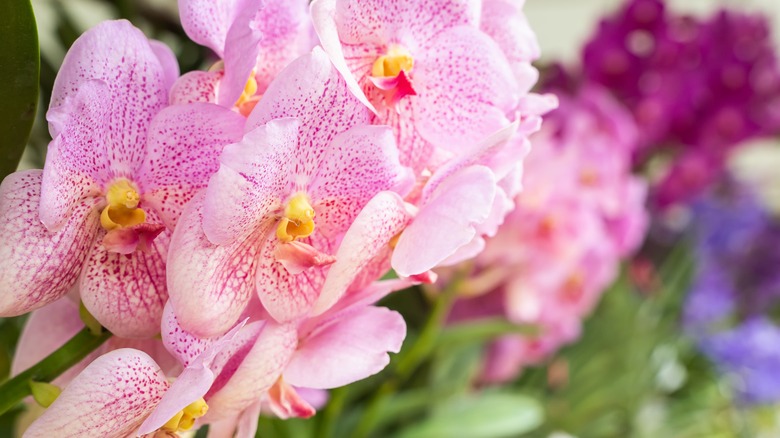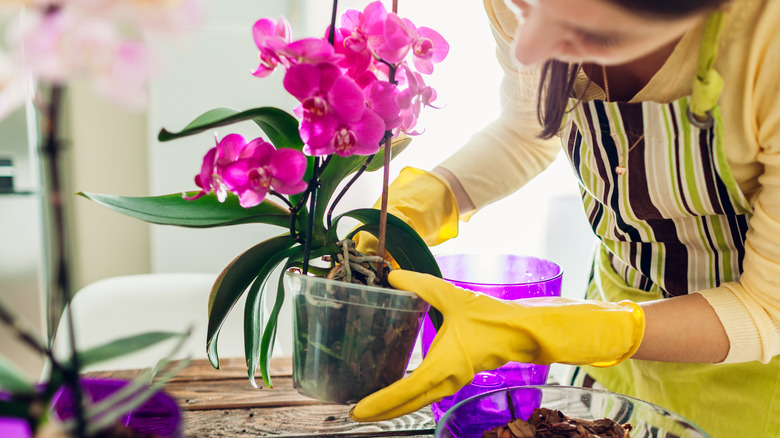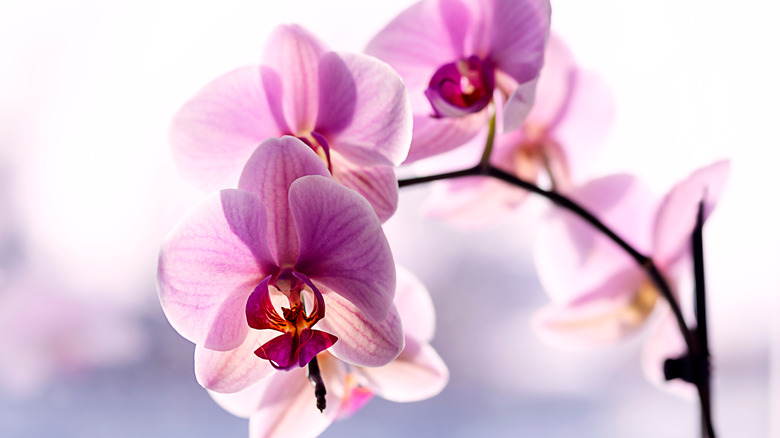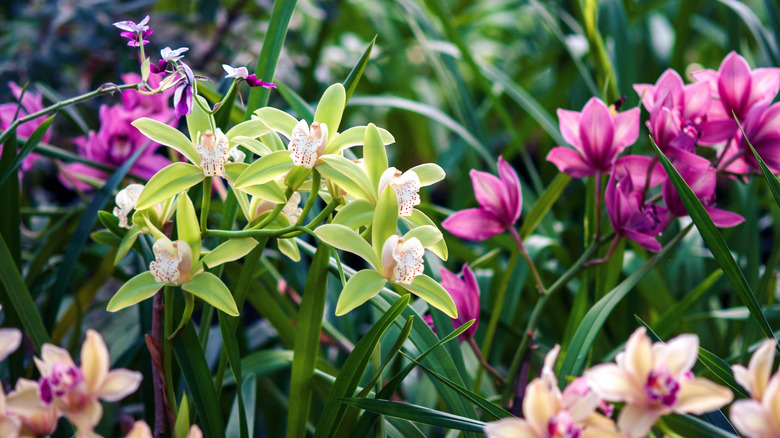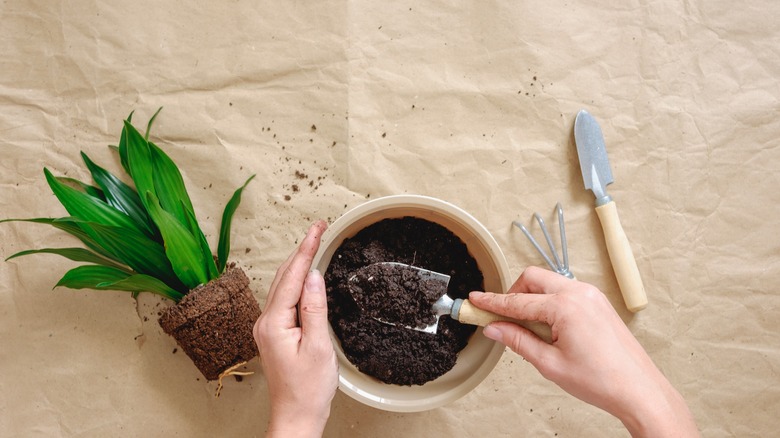How To Successfully Care For Indoor Orchids
Orchids are a beautiful addition to any space. Often associated with the tropics of Hawaii, they can bring a piece of the islands indoors and provide an escape from cold, gray weather. In more practical cases, certain species of orchids are used to produce vanilla from their dried seed pods. Most orchids have multiple flowers and bilateral symmetry. According to Plainview Pure, orchids have the smallest seeds in the world, and one seed pod can contain up to three million seeds. Their flowers range in color from pink to orange to white to blue. Most bloom annually or biannually and can live for years or sometimes decades when given the proper care.
Humans have been keeping orchids in their homes since ancient times; Confucius even wrote a poem about them. Their bright colors and fragrance make them among the most popular houseplant, but they are notoriously hard to maintain. If you're up for the challenge, growing orchids can be a rewarding task.
How to grow indoor orchids
After buying an orchid plant, take it out of the pot and cut away any brown, rotted roots. Healthy roots are white to pale gray. Then add soil; orchids grow well in peat moss. They also require airflow around the roots, so be sure to lightly pack in soil but leave some room for air to flow through. Orchids require heavy watering followed by a dry period. Tightly packing the soil will prevent the roots from ever drying out and will cause root rot.
Place your orchids somewhere where they will receive sunlight, but not harsh or direct light. The Spruce recommends an east-facing window. While it's growing, it is good to use a fertilizer. According to the American Orchid Society, a balanced 20-20-20 fertilizer works best. They say it is better to under-fertilize your plant than over-fertilize it, so be conservative with how much you use.
How to care for indoor orchids
To keep your orchids healthy, be sure to keep them in a room between 60 to 80 degrees. Humid environments usually work best. They should be watered every 7 to 10 days. Check the condition of the soil before watering. If it is dry to the touch, it is time to re-water. If the roots are bright green, this may be a symptom of overwatering; healthy roots are typically a white to pale green color.
Hunker says the bloom time of an indoor orchid is usually in the winter and can last until early spring. During the bloom, do not repot your orchids and do not move their location, as they are probably accustomed to the light and temperature. If your orchid is large, it may require support. You can provide support by placing a stake in the soil and attaching it to the plant with ties or clips. Once out of its bloom phase, the flower will begin to wilt and fall. The plant is in a resting phase, in which its focus is strengthening roots for the next bloom.
Varieties of orchids
In terms of variety, the orchid family is one of the most impressive in the plant world. There are around 28,000 species of orchid, and they make up between 6% to 11% of known seed plants.
- Phalaenopsis, or moth orchids, are one of the most popular varieties of orchids for inside the home. They are native to Southeast Asia, Australia, India, and China. Moth orchids are popular to grow indoors because they are among the easiest to care for outside of their natural habitat.
- Dendrobium, or cane orchids are the other popular variety for inside the home. This variety is typically more resistant to high heat and sunlight, so they are a good choice if you live in a hotter climate or have high sun exposure in your home. Like Phalaenopsis orchids, Dendrobium orchids are native to Southeast Asia, Australia, India, and China.
- Vanilla planifolia, or flat-leaved vanilla, is the orchid that commercial vanilla is derived from. However, there are 110 different varieties of vanilla orchids.
- Cymbidium, or boat orchids, have smaller blooms than other varieties but can produce up to 30 blooms per spike. They are popular in gardens.
- Psychopsis, known as butterfly orchids, have a distinct look as their open-face blooms resemble butterflies. They are easy to maintain because they're tolerant to a wider range of temperatures than most varieties.
Are orchids toxic?
The ASPCA says that Phalaenopsis orchids are non-toxic to dogs, cats, and horses. Most orchids are safe to keep in the house and do not pose a threat to animals or humans, even when ingested — but there are some exceptions. The Lady Slipper orchid is rated as mildly toxic by the California Poison Control System. It has a toxicity rating of one, which means that it can cause a dermal reaction like redness or rash. Various other types of orchids are rated as non-toxic by the CPCS.
Since there are so many different species of orchids, they have not all been extensively studied. Use more caution when in contact with wild orchids. But know that the most popular indoor orchids are completely safe for pets and humans. Though they're non-toxic, they are also not edible and can cause an upset stomach when ingested. They can also be a choking hazard, so it is still best to keep them out of reach if you have a curious pet.
How to repot orchids
According to Chicago Botanic Garden, orchids should be repotted when you first buy them, and then once every year or two following. A sign that it's time to repot is when the roots grow up and out of the soil, becoming visible. Do not repot your orchids while they're in bloom.
The first step to repotting is removing the orchid from the original pot. Try to gently loosen the roots from the soil with your hands. You should then feel the roots. If they're dry, soak them for a few minutes so that they're not brittle and prone to breakage. Once the roots have been soaked, untangle them and trim away any blackened or rotting portions. A healthy root should feel firm. Once you've successfully separated the roots, place your orchid into a new pot; this one may need to be slightly bigger than the last. Pour your potting mix in and lightly pack it in, making sure the mix is still breathable. Finally, water your orchid completely and then give it between one to two weeks before re-watering.
